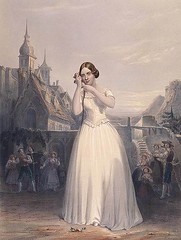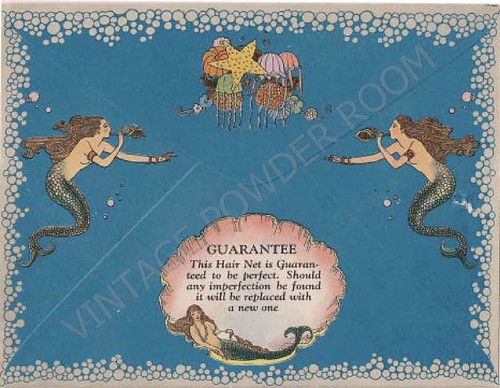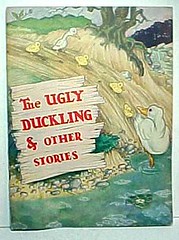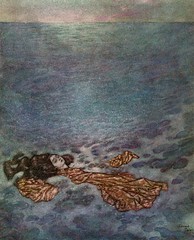Wed 1 Dec, 2010
MERMAID
Comments (0) Filed under: Hair Net PackagesTags: Copenhagen, Hans Christian Andersen, Jenny Lind, The Little Mermaid
This is just embarrassing – I’ve had my Halloween post up for the entire month of November! Clearly it is time to get back to work, and what better way to kick things off than with this lovely hairnet package. The package is dated 1925, and was designed and/or printed by Seidner & Hitzigrath in New York.
The package is unprinted, that is there’s no brand name on it. I can only imagine what fanciful name a company could have devised for this package.
Of course when thinking of mermaids, the Hans Christian Andersen tale of the The Little Mermaid immediately comes to mind. Fairy tales, particularly Andersen’s, are so frequently painful reflections on love, loss, and rejection that I wonder why parents would ever have chosen to read them to a child. Yet he has always been widely acclaimed for entertaining and delighting children (The Ugly Duckling still makes me cry!). Having said that, I don’t necessarily find the stories great reading to or for a child. The tales illuminate some of the most remarkable traits of the human spirit (even when the “human” is a mermaid or a duckling); the quest to find oneself through sacrifice and/or love.
Sacrifice and the quest for an immortal soul is the thread that runs through The Little Mermaid. The story sounds more like something from Plato than from a Danish writer of children’s books. Plato believed in an immortal soul and, apparently, so did the Mermaid; she went to extraordinary lengths to acquire her heart’s desire. Her longing for a soul would ultimately end her life as a mermaid (she would dissolve into foam) and deny her the Prince of her dreams.
Andersen’s own longing for love was unrequited. At one point he wrote in his diary: “Almighty God, thee only have I; thou steerest my fate, I must give myself up to thee! Give me a livelihood! Give me a bride! My blood wants love, as my heart does!
Christian fell in love with the famous opera soprano, Jenny Lind (whose nickname, “The Nightingale”, was inspired by one of Andersen’s stories). He finally found the courage to propose to her, in a letter that he handed to her as she boarded a train. Her answer to him was: “farewell… God bless and protect my brother is the sincere wish of his affectionate sister, Jenny”.
Andersen appears to have been drawn to unattainable people of both sexes. Andersen wrote to Edvard Collin: “I languish for you as for a pretty Calabrian wench… my sentiments for you are those of a woman. The femininity of my nature and our friendship must remain a mystery.” Collin, who did not prefer men, wrote in his own memoir: “I found myself unable to respond to this love, and this caused the author much suffering.”

Although Andersen was unable to find love at a personal level, he received it on a far grander scale. At the time of his death, he was an internationally renowned and treasured artist. He received a stipend from the Danish Government as a “national treasure”. Before his death, steps were already underway to erect the large statue in his honor, which was completed and is prominently placed at the town hall square in Copenhagen.
There is a statue of the The Little Mermaid in Copenhagen Harbor, as well as tributes to him in Solvang, California, and in Lublin, Poland.
Andersen’s birthday (April 2) is celebrated as International Children’s Book Day. That’s an extraordinary legacy.





